Microbes are going to orbit the Earth's atmosphere for six months, the first mission since the 1970s to test how a life form handles the conditions outside the protection of the earth's magnetic field, according to Space Daily.
The O/OREOS (Organism/Organic Exposure to Orbital Stresses) astrobiology nanosatellite mission goal is to demonstrate the capability to do low-cost science experiments on autonomous nanosatellites in space in support of the Astrobiology Small Payloads program. Although the NASA Ames Small Spacecraft division manages the O/OREOS mission, all of the operations are conducted by staff and students from the Robotic Systems Laboratory at Santa Clara University. The mission should help answer Astrobiology's fundamental questions on the origin, evolution and distribution of life. (How's that for a kick-ass dissertation!?!)
.jpg)
In an effort to assess survival and adaptation to stress, the microorganisms Halorubrum chaoviatoris and Bacillus subtilis will orbit the Earth in a 5.5kg automated laboratory. The spacecraft, which is about the size of a loaf of bread, is equipped with sensors that will monitor the internal pressure, temperature, humidity, radiation and acceleration while communications system regularly transmit data back to earth for scientific analysis. The organisms will reside within a self-contained vessel that is regulated for pressure, humidity and temperature. Growth media will be provided to the organisms as they are exposed to the high-energy radiation and microgravity conditions. After O/OREOS reaches orbit, the experiment will initiate and begin to rehydrate and expose three sets of the microbes to media at three different times: a week, three months and six months after launch. A three-color LED and detector will monitor growth and metabolism using a colorimetric assay.
A second experiment on the coolest space-lab evah will monitor the stability and changes in four classes of organic matter as they are exposed to space conditions. The stability will be assessed by studying in-situ changes in UV, visible and near-infrared light absorption through a daily measurement.




1 comment:
THis sounds cool. THough, apparently worms were on the space shuttle that blew up over texas. Wouldn't they have been the first life forms?
Post a Comment